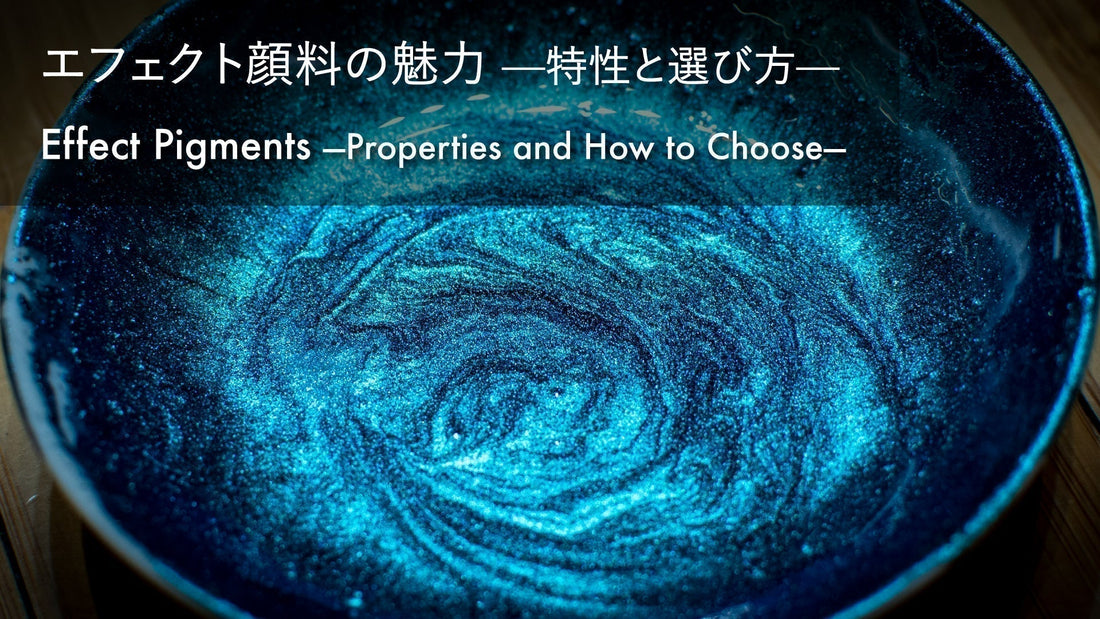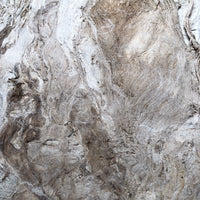Effect (Pearl) Pigments
Originally, effect pigments derived from natural minerals and metals were widely popular. However, synthetic pigments have become the norm nowadays, created through chemical reactions by minerals and metals, or by coating the base materials with different substances. The latest technologies have enabled the production of pigments with high brightness and optical visual effects by applying coating treatments to base materials such as mica, metals, and glass.
The most notable features of these pigments are polarizing color by light reflection and refraction, as well as their brilliance which surpasses metals or pearls. While effect pigments are commonly used in industrial products or printings such as automobile coatings and cosmetics, all the products offered at PIGMENT TOKYO are designed explicitly as art materials.
Polarization (Interference)
Polarization is an effect caused by light interference.
Polarizing pigments appear with different hues depending on how the light hits or the viewing angle. The colors produced by this optical effect are often called interference colors, characterized by glossy, colorful stripes (moire patterns).
Types and Characteristics
Effect pigments are made using five different base materials, each offering different characteristics and effects. Although the base materials are colorless, the resulting colors vary depending on the characteristics of the material, the substances used for coating, and the types or thickness of the coating layer. Even with the same materials or colors, the effects are diverse.
The particle size of effect pigments, noted in product descriptions as "µm (micrometers)," is smaller than mm (millimeter) but larger than nm (nanometer).
・ Order of size: 1 nm < 1 µm < 1 mm
Main Base Materials
◾️Mica
Mica is the most popular base material for effect pigments. Initially referring to a natural mineral, mica is now available in natural and synthetic forms. It is also widely used as a pigment for art material.
Characteristics:
・ Large particle size
・ Wide variety of pigments
[Py] ... Coated with specially developed titanium oxide
[Ir] ... Coated with a layer of metal oxide
Flamenco ... Coated with titanium oxide and iron oxide
INTENZA ... Synthetic mica with highly safe organic dyes
Cloisonne ... Coated with titanium oxide and iron oxide
Duo Chrome ... Coated with titanium oxide and iron oxide
Gem Tone ... Coated with titanium oxide and iron oxide
Please refer to this article for further details and historical information about mica.
◾️Silica
Silica, a type of mineral, contains silicon as one of its constituent elements.
Characteristics:
・ Colors of pigments and their reflected light appear differently depending on the viewing angle
・ High whiteness
[Co] ... Coated with metal oxides such as titanium oxide or iron oxide
◾️Glass
Glass-based pigments are characterized by their unique transparency and brilliance.
Characteristics:
・ High transparency
・Coarse texture / large particle sizes (up to 200 µm)
・ High brilliance and luster
[Mi] ... Borosilicate glass coated with metal oxide
Metashine ... Glass flakes coated with metal or metal oxide
◾️ Aluminum
Metal has a light silver color with strong reflection of color and light.
Characteristics:
・Metallic color
・High coverage
・High opacity (compared to other effect pigments available at PIGMENT TOKYO)
Chromashine ... Aluminum flakes coated with silica + plated with metal particles
Astroflake ... Colored aluminum leaves (colored with modified acrylic resin)
◾️ Alumina
Alumina is an aluminum oxide.
Characteristics:
・ High color saturation
・ High brilliance
[Xi] ... Coated with metal oxides
[Me] ... Paste pigments using high-purity alumina flakes as base material
How to Choose Effect Pigments
PIGMENT TOKYO offers a selection of 15 types of effect pigments, encompassing over 200 colors (as of November 2024).
However, identifying the ideal sparkle and color from the vast array of available options can take time and effort. This section will guide several vital terms describing the characteristics of effect pigments, which could be a guide when selecting pigments.
Colors will change depending on the application techniques and mediums used with the pigments.
We recommend you test them on samples before using them for your final artwork.
* Please note that the product image and the actual visible color may differ.
Enjoying Polarization
Some polarization pigments can appear different depending on the color of the base layer. For example, the color may appear different even if the same pigment is applied to a black base layer or white base layer. This phenomenon occurs because effect pigments with high transparency are more likely influenced by the base color, causing the applied color to appear different depending on the underlying color.
On the other hand, pigments with low transparency and high opacity are less affected by the base color, providing consistent colors regardless of the underlying color.
Enjoying Luminous Coloration
Like how the presence or absence of gloss can alter the impression of the same color, similar hues can also change in visual appearance depending on factors such as the intensity of polarization, transparency, and the size of the pigment particles. Also, there are color appearances unique to the effect pigments.
◾ Colors That Change Significantly Depending on the Base Color
Here are examples of pigments with high transparency influenced by the base color, causing the applied color to change.[Py] Flamenco
Base material: Mica
The applied color changes significantly depending on the base color.
The delicate particles create a smooth, silky, and refined luster. The vivid color expression of [Py] and the subdued tones of Flamenco each express their unique characteristics. Please explore each product page to discover what suits your preferred color.
In this comparison article about [Py] pigment, using acrylic emulsion and gel medium, you can explore how the base color and medium affect the result and the subtle nuances of color achieved through blending.
Duo Chrome
Base material: Mica
RB shows a purple hue on a black base and a pink hue on a white base, while YB shows a grayish tone on black and a salmon pink tone on white. Compared to these two colors, the others offer a more subtle and gradual shift in tone.
The alphabet letters at the end of the product name for Duo Chrome represent the color characteristics. The first letter indicates the base color, and the second letter represents the polarizing color.
For example, in the case of RB:
Base color...R (Red)
Polarization color...B (Blue)
R= Red / Y =Yellow / G=Green / B=Blue / V=Violet
[Ir]
Base material: Natural Mica
This material features a wide range and variety of results, from soft hues to those with solid luster and interference effects.
[Colors that change significantly depending on the base color]
This article includes sample images comparing the applied colors of [Ir] Scarab red 9507 and [Ir] Rutile Red Pearl 215, highlighting the differences in particles, paint, and base material color.
[Co]
Base material: Silica
We offer the T20 series, which undergoes noticeable color changes due to polarization, and the
F20 series. known for its strong opacity.
[Colors that significantly change depending on the base color]
[Co] Tropic Sunrise T20-03 [Co] Lapis Sunlight T20-04 [Co] Viola Fantasy T20-01
[Mi]
Base material: Glass
There is the Scenic series, with particle sizes ranging from Φ10–100µm, and the Magic and Twinkle series, which is one of the 5400 series with more noticeable particle texture and particle sizes from Φ20–200µm.
[Colors that significantly change depending on the base color]
[Mi] Scenic([Mi] Scenic Gold ) / [Mi] Magic series([Mi] Magic Blue )
Metashine
Base Material: Glass
All colors exhibit significant changes in the applied color depending on the base color.
The brilliance emitted by large particles showcases the most prominent visual effects of the glass substrate.
The particle sizes range from φ80µm (Titannia Court 1080), Φ90 µm (Silver Coat 5090), Φ150 µm (Silver Coat 5150), Φ480 µm (Silver Coat 5480), Φ600 µm (Titannia Court 5600 Series), offering a wide variety.
-

MICROGLAS® METASHINE®
Titania Coat GT1080RB (Blue)See the product -

MICROGLAS® METASHINE®
Silver Coat MC5150PSView products -

MICROGLAS® METASHINE®
GT5600RB (Blue)View products
When used as paint, large particles of Metashine require a binder with good adhesion. You can view a sample test with acrylic resin and mixed paint here.
[Xi]
Base Material: Synthetic Alumina Flake
The finely textured luster and the high brilliance and brightness of the alumina substrate are created by particle sizes ranging from Φ5–30μm.
[Colors that significantly change depending on the base color]
◾ Colors Less Affected by the Base Color
These pigments bring out the color effects of light, regardless of the base color.
Chromashine®
Base material: Aluminum powder
Chromashine® is a new type of metallic pigment.
With excellent opacity and low transparency, it is less affected by the base color than other effect pigments, allowing it to maintain its high saturation.
The image shows the appearance of the pigment mixed with gum arabic. Interference colors could be observed even in this state.

Cloisonne Gem Tone
Base material: Mica
The fine, lustrous Cloisonne and the slightly matte Gem Tone have a more subtle luster and opacity than Chromashine®.
Article about acrylic paint sample creation, focusing on the colors of Gem Tone is also available.
◾️ Vibrant Color Effect
This pigment is also less affected by the base color, allowing it to produce vibrant and beautiful effect colors in various settings.
[Me]
Base material: High-purity alumina flakes
This high-brightness and highly saturated orange and yellow effect pigment is made from fine particles, and formulated into a paste.
INTENZA
Base material: Synthetic Mica
This article introduces the unique, vivid colors and excellent dispersibility of INTENZA.
Astroflake
Base material: Aluminum Leaf
Colored with a modified acrylic type, it features vivid colors and a beautiful luster.
The Astroflake, with a thick texture, is made of larger pigment particles. Due to this, the binder must be adjusted according to the intended application.
This article explains the painting samples and critical points for various paints mixed with gum arabic, acrylic emulsion, and gel medium.
◾️ Gold, Silver, and Copper
Basic gold, silver, and copper pigments are discussed in this article.
Usage
The effect pigments in our lab can be mixed with various binders such as animal Glue, gum arabic, acrylic emulsion, and oil color medium to create different types of paints. They can also be used with other available paints, mediums, and art supplies.
Please refer to this article for the basic method of making paints.
We also recommend this article about advanced applications of effect pigments for those looking to expand their creative range and explore more complex expressions.
As with other pigments, some effect pigments may be challenging to incorporate into water-based paints due to differences in particle size and specific gravity. Adding Pigment Dispersant for Aqueous Paint can help achieve a smooth and beautiful color.
The combination of material properties and advanced technology has led to the development of effect pigments, which create new forms of expression by manipulating light. These pigments offer limitless potential, and we encourage you to explore the wide range of expressions they can create.


















